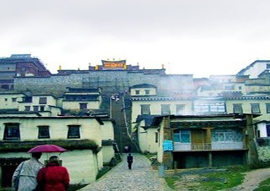Songzanlin Monastery is the largest Tibetan Buddhist monastery in southwest China and one of the famous monasteries in the Kang region. The monastery is located near Shangri-La County and 5 kilometers away from Zhongdian County, at the foot of Foping Mountain.
Songzanlin Monastery has another alias - ‘the little Potala Palace’, so named because the whole monastery is in the traditional style with mysterious atmosphere. In 1679, Dalai Lama chose this place by divination, and it went on to become the uppermost public place in Yunan which features the particular local characteristics. Annually, the Gedong Festival is celebrated here by the Tibetans. Pious believers, with their knees and foreheads knocking the ground at every step, come here to pray
The journey up the steps that lead to the main prayer hall can prove to be an arduous undertaking. However, it allows people to briefly experience the hardship of the pilgrimage route that generations of Buddhists living on the plateau take every year. The main hall in the center of the complex features imposing pillars and murals, which vividly depict the traditions and beliefs of Tibetan Buddhism, such as the ‘wheel of life’; that illustrates the six realms of existence-heaven, demigods, humankind, hell, hungry ghosts and animals.
Construction of the monastery started in 1679 and was accomplished two years later. The monastery seems like a group of ancient castles and is composed of two lamaseries, Zhacang and Jikang. It has a solemn main hall with 108 (an auspicious number in Buddhism) red pillars and scores of colorful thangka hanging from the ceiling. The main halls in the monastery are magnificent, and on both the left and the right sides are wonderful frescos, depicting Buddhist tales and legends. The inside-halls are exquisite with cloisters running through. The gilded copper roof endows the monastery with strong Tibetan features and the 108 columns downstairs also feature the monastery with characteristics of Han nationality. The cloisters are all decorated with elegant sculptures and consummate frescos. Ascend to the roof, where a simply glorious panorama of Zhongdian awaits you. In the living quarters of the Living Buddha, check out the smooth marks along the floor, where thousands have prostrated themselves in front of the Lama. One may even be able to find a monk who can point out the nearby mountain to the south used for Tibetan sky burials.
The incense drifting in wisps, the fragrant oil lamps and the number of old monks instructing younger ones, can give one the impression that time has stood still in this little paradise since the creation of the temple. Because the monastery is situated in the high altitude region over 3,300 meters (about 10,827 feet) high, it snows even in August, and has a rainy season that runs from June through September. Therefore, spring and summer are the best seasons for people to visit it. |
